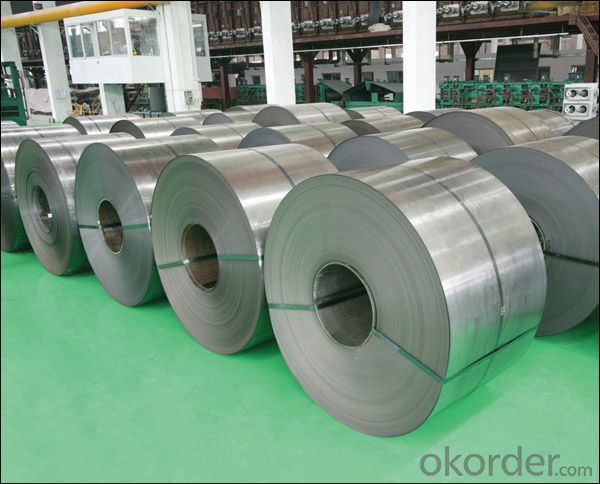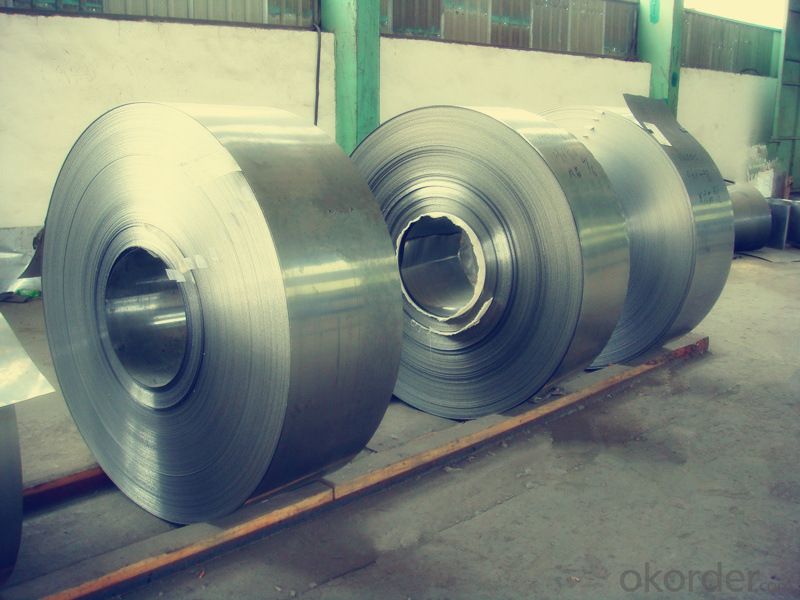Stainless Steel Coil 201 Hot / Cold Rolled Coil Narrow Coil
- Loading Port:
- Lianyungang
- Payment Terms:
- TT OR LC
- Min Order Qty:
- 400 m.t.
- Supply Capability:
- 5000 m.t./month
OKorder Service Pledge
OKorder Financial Service
You Might Also Like
Hot Rolled Stainless Steel Coil 201 Narrow Strip No.1 Finish
Packaging Detail: For customer's requirement
Delivery Detail: 10-30days
201 Hot Rolled Stainless Steel Coil Specifications
THK:2.3/2.5/3.0/4.0mm
Width:485/510/550/610/1010/1240mm
Face:No.1
201 Hot rolled Stainless Steel Coil Application
Stainless steel is a production which not easy rust,acid resistance and corrosion resistance,so it is widely
used in light industry,heavy industry,daily necessities and the decoration industry.
201 Hot Stainless Steel Coil Chemical Composition(WT%)
(C):≤0.15, (Si):≤0.75, (Mn):5.5~7.50, (Cr):16.0~18.0, (N):≤0.25, (Ni):3.50~5.50, (P):≤0.060, (S):≤0.030
201 Hot Rolled Stainless Steel Coil
Strength Of Extension:100,000 To 180,000 Psi;
Yield Strength:50,000 To 150,000 Psi
Elongation :55 To 60%;
Modulus Of Elasticity:29,000,000 Psi;
Density :.280lbs/Cubic Inch(7.93g/Cm3)



- Q:Can stainless steel strips be used in chemical reactors?
- Yes, stainless steel strips can be used in chemical reactors. Stainless steel is widely used in chemical industries due to its excellent corrosion resistance properties. It is resistant to various chemicals, including acids, bases, and organic solvents, making it suitable for use in chemical reactors. Stainless steel strips can be fabricated into various shapes and sizes to meet the specific requirements of a chemical reactor. Additionally, stainless steel's high strength and durability make it ideal for withstanding the harsh conditions and pressures often encountered in chemical processes.
- Q:How can stainless steel strips be protected against scratches?
- To safeguard stainless steel strips from scratches, various precautionary measures can be taken. Firstly, the application of a protective film or tape on the strip's surface acts as a temporary barrier during transit or handling, shielding it from potential scratches. These films, composed of durable materials resistant to scratches, can be effortlessly removed upon reaching their final destination. Furthermore, long-term protection against scratches can be achieved by utilizing a clear coat or protective coating specifically designed for stainless steel. These coatings establish a safeguard between the metal surface and any abrasive materials, effectively minimizing the risk of scratches. It is of utmost importance to select a coating that is compatible with stainless steel and appropriate for the intended application. Adopting proper handling techniques is another effective approach to shield stainless steel strips from scratches. This involves refraining from dragging or sliding the strips on rough surfaces and utilizing gentle materials such as cloth or foam pads when moving or handling them. Regular cleaning and maintenance play a crucial role in preventing scratches on stainless steel strips. Employing non-abrasive cleaning agents and soft cloths or sponges aids in avoiding surface scratches. It is imperative to always wipe in the direction of the grain to minimize the possibility of creating scratches. Lastly, storing stainless steel strips in a controlled and clean environment significantly contributes to their protection against scratches. Avoiding contact with sharp or abrasive objects and keeping the strips in a designated area where they are less likely to be bumped or scratched ensures their preservation. By implementing these preventive measures, stainless steel strips can be effectively safeguarded against scratches, guaranteeing their durability and aesthetic appeal are maintained.
- Q:Can stainless steel strips be used in pharmaceutical packaging?
- Yes, stainless steel strips can be used in pharmaceutical packaging. Stainless steel is often used in the pharmaceutical industry due to its corrosion resistance, durability, and ease of cleaning. It is commonly used for manufacturing vials, syringes, and other packaging materials to ensure the safety and integrity of pharmaceutical products.
- Q:How do you select the right grade of stainless steel strip for a specific application?
- To select the right grade of stainless steel strip for a specific application, several factors must be considered. These factors include the corrosive environment, temperature range, mechanical requirements, and the desired appearance or finish. It is crucial to evaluate the chemical composition, corrosion resistance, strength, and ductility of different stainless steel grades to ensure they meet the specific needs of the application. Additionally, consulting with experts and conducting thorough research on the various grades available can aid in making an informed decision.
- Q:Can stainless steel strips be used in electrical enclosures?
- Yes, stainless steel strips can be used in electrical enclosures. Stainless steel is a popular choice for electrical enclosures due to its corrosion resistance, durability, and ability to withstand harsh environments. Stainless steel strips can be used to reinforce the structure of the enclosure or to provide grounding. Additionally, stainless steel has good electrical conductivity, which makes it suitable for use in electrical applications. It is important to choose the appropriate grade of stainless steel based on the specific requirements of the enclosure to ensure optimal performance and longevity.
- Q:What is the thickness range of stainless steel strips?
- The thickness range of stainless steel strips can vary depending on the specific application and requirements. Generally, stainless steel strips are available in thicknesses ranging from 0.02 millimeters to 5 millimeters. However, it is important to note that custom thicknesses can also be manufactured to meet specific needs. The selection of the appropriate thickness depends on factors such as the intended use, structural requirements, and desired aesthetics.
- Q:Can 111 stainless steel strips be used in the pharmaceutical industry?
- Yes, 111 stainless steel strips can be used in the pharmaceutical industry depending on their specific characteristics and properties. Stainless steel is often used in pharmaceutical manufacturing due to its corrosion resistance, hygiene, and durability. However, it is important to ensure that the specific type of stainless steel (such as 111) meets the industry's requirements and standards before considering its use.
- Q:Are stainless steel strips suitable for heat exchangers?
- Stainless steel strips are indeed suitable for heat exchangers. The reason lies in the fact that stainless steel possesses exceptional corrosion resistance, high strength, and thermal conductivity, thereby rendering it an ideal material for heat exchangers. These devices serve the purpose of transferring heat between two fluids while ensuring their separation, and stainless steel strips are fully capable of enduring the involved high temperatures and pressure differentials. Moreover, stainless steel can be easily cleaned and maintained, a crucial factor in guaranteeing the efficiency and longevity of heat exchangers. Ultimately, stainless steel strips emerge as a dependable and long-lasting option for heat exchangers across diverse industries such as chemical, petrochemical, HVAC, and food processing.
- Q:Are stainless steel strips resistant to nitric acid?
- Yes, stainless steel strips are generally resistant to nitric acid. Stainless steel is known for its excellent corrosion resistance properties, and it exhibits good resistance to a wide range of acids, including nitric acid. However, the level of resistance may vary depending on the specific grade or alloy of stainless steel being used, as well as the concentration and temperature of the nitric acid. It is always recommended to consult the stainless steel manufacturer or supplier for specific information on the resistance of their products to nitric acid in your specific application.
- Q:What is the thermal conductivity of stainless steel strips at different temperatures?
- The thermal conductivity of stainless steel strips can vary depending on the specific grade of stainless steel and the temperature at which it is measured. However, in general, stainless steel is known for its relatively low thermal conductivity compared to other metals. At room temperature (around 25°C or 77°F), the thermal conductivity of stainless steel strips typically ranges from 14 to 19 watts per meter-kelvin (W/m·K). As the temperature increases, the thermal conductivity of stainless steel tends to decrease slightly. For example, at elevated temperatures such as 200°C (392°F), the thermal conductivity of stainless steel may decrease to around 12 to 17 W/m·K. Similarly, at extremely high temperatures, such as 1000°C (1832°F), the thermal conductivity of stainless steel can further decrease to approximately 8 to 12 W/m·K. It is important to note that these values are approximate and can vary depending on factors such as the specific alloy composition, impurities, and processing methods used in manufacturing the stainless steel strips. Therefore, for accurate and precise thermal conductivity values at different temperatures, it is recommended to consult the technical datasheet or contact the manufacturer of the specific stainless steel strip being used.
1. Manufacturer Overview |
|
|---|---|
| Location | |
| Year Established | |
| Annual Output Value | |
| Main Markets | |
| Company Certifications | |
2. Manufacturer Certificates |
|
|---|---|
| a) Certification Name | |
| Range | |
| Reference | |
| Validity Period | |
3. Manufacturer Capability |
|
|---|---|
| a)Trade Capacity | |
| Nearest Port | |
| Export Percentage | |
| No.of Employees in Trade Department | |
| Language Spoken: | |
| b)Factory Information | |
| Factory Size: | |
| No. of Production Lines | |
| Contract Manufacturing | |
| Product Price Range | |
Send your message to us
Stainless Steel Coil 201 Hot / Cold Rolled Coil Narrow Coil
- Loading Port:
- Lianyungang
- Payment Terms:
- TT OR LC
- Min Order Qty:
- 400 m.t.
- Supply Capability:
- 5000 m.t./month
OKorder Service Pledge
OKorder Financial Service
Similar products
New products
Hot products
Hot Searches
Related keywords































